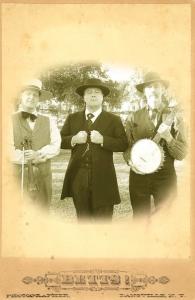What Makes a Good Living History Costume
Historical correctness, simplicity and appropriateness are what make a good costume for a living history interpreter.
Historical Correctness
In terms of historical correctness, it should, of course, be cut in a manner that is right for the time and place being portrayed. That should go without saying, but I have seen too many hoop skirts in 1880s portrayals and bustles lurking about the Civil War.
 Further, all the key elements need to be present. If you are dressing as a proper sort of gentleman, you need to have a coat, a vest and a hat--and all need to be right. If you are dressing as a fashionable woman, you need a corset and other underpinnings that make the right line.
Further, all the key elements need to be present. If you are dressing as a proper sort of gentleman, you need to have a coat, a vest and a hat--and all need to be right. If you are dressing as a fashionable woman, you need a corset and other underpinnings that make the right line.
A further benefit of having a complete costume (and this applies more to men than to women), is that if you need to remove some elements (like removing a coat), you can still be visually correct--if perhaps improperly dressed.
A major part of historical correctness is choosing the right fabric. Not only does correct fabric look right at close range, but it ages properly. A synthetic might look okay the day you make it, but as sun and washing take its toll, it will start to look wrong. Wool and linen are amazing resilient, and when they do age, they just look like old wool and linen.
Simplicity
The number one rookie mistake is wanting to be fancy, and not being quite sure how to go about it or lacking the budget to buy correct fabrics and trims. Simple is a far safer bet, especially for the novice, than fancy and will actually look far more flattering and convincing than an imperfectly executed fashion plate.
The ultimate in simplicity is the dress called the "wrapper" (also called a "Prairie Dress"). This is a simple 19th Century house/farm dress. It is easy to make, looks good and wears well--and for women who don't want to do the corset thing, can be worn without one.
For men doing 19th Century working class, you have it really easy. Just find an off the rack pair of canvas work pants, a 19th Century style pull over shirt, some sturdy boots and a beat up hat. You will be comfortable on the hottest day, and look right. You won't look like a fine gentleman, but if you aren't up to the task, don't try it and fall short. Go with what you can easily do.
Appropriateness
This is simply dressing to fit the time and place you are portraying. If you are interpreting a ranch, dress like country people. If you are interpreting a Queen Anne style Victorian, dress like middle class city folk or their servants.
